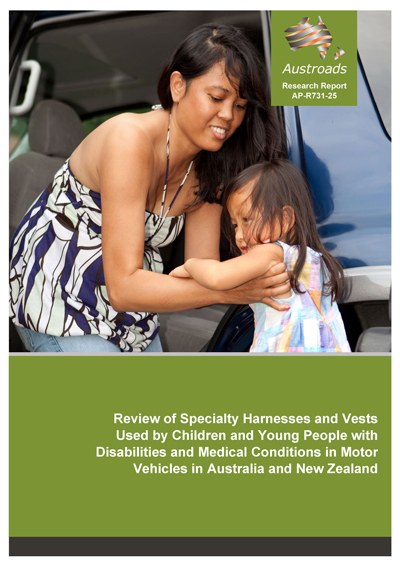Road Safety

- Publication no: AP-R731-25
- ISBN: 978-1-922994-63-9
- Published: 11 March 2025
- PDF (free) Download
The purpose of this report is to investigate specialty harnesses and vests used by children and young people with disabilities and medical conditions in motor vehicles, with the aim of informing the development of guidance and standards for their adoption and use.
This research project was undertaken for both Australia and New Zealand, using a range of methodologies, including:
- an online survey
- a desktop review of products, vehicle types that specialty harnesses/vests are used in, compliance with standards and road laws, and potential safety and usability issues
- engagement of experts to develop recommendations for the safe use of specialty harnesses/vests in motor vehicles.
This report has significantly improved knowledge about specialty harnesses/vests. It identified road safety challenges associated with the selection and use of some specialty harnesses/vests, and gaps in standards, regulations and support for parents. Expert safety recommendations have been developed to guide the appropriate selection and use of products in passenger cars. The Expert Group found that guidance materials are needed for implementation, and further research is required to understand the use of specialty harnesses/vests in school buses.
Join us for a webinar on 5 June presented by authors, MACA Chief Executive Helen Lindner and Professor Julie Brown, to learn more about this world-leading project.
There will be question and answer opportunities during the session. No charge but registration is essential. Can’t make the live session? Register and we’ll send you a link to the recording.
- Summary
- Definitions
- Abbreviations
- 1. Introduction
- 1.1 Purpose
- 1.2 Background
- 1.2.1 Mobility and Accessibility for Children and Adults Ltd (MACA)
- 1.2.2 Australian Safety Assessment Program (AuSAP)
- 1.3 Scope
- 1.4 Methodology
- 1.4.1 Online Survey
- 1.4.2 Desktop Review
- 1.4.3 Engagement of Experts
- 1.5 Document Structure
- 2. Survey and Other Data
- 2.1 Survey Findings
- 2.1.1 Products Used
- 2.1.2 Ages of Children Using Products
- 2.1.3 Types of Vehicles
- 2.1.4 Sources of Advice
- 2.1.5 Where Consumers Obtain Products
- 2.1.6 Why Specific Products are Selected
- 2.2 Experience of Parents and Allied Health Professionals
- 2.2.1 Key Insights
- 2.3 Supported School Bus Transport
- 2.4 Key Points (Summary)
- 2.1 Survey Findings
- 3. Specialty Harnesses/Vests
- 3.1 Product Reviews
- 3.2 Instruction Manuals
- 3.2.1 Findings
- 3.3 Installation and Use
- 3.4 Key Points (Summary)
- 4. Standards
- 4.1 Australian/New Zealand Standards
- 4.1.1 AS/NZS 1754 Child Restraint Systems for Use in Motor Vehicles
- 4.1.2 AS/NZS 4370 Restraint of Children with Disabilities or Medical Conditions in Motor Vehicles
- 4.1.3 AS 5384 Accessories for Seat Belts Used in Motor Vehicles
- 4.2 Overseas Standards
- 4.2.1 FMVSS 213
- 4.3 Key Points (Summary)
- 4.1 Australian/New Zealand Standards
- 5. Safety and Usability (Themes)
- 5.1 Key Themes
- 5.1.1 Attachment to Vehicle
- 5.1.2 Restrictive Features
- 5.1.3 Seatbelt Use
- 5.1.4 Age/Size of User
- 5.2 Combination Use
- 5.3 Key Points (Summary)
- 5.1 Key Themes
- 6. Expert Consultation and Recommendations
- 6.1 Establishment of Expert Group
- 6.2 Recommendations
- 6.2.1 Further Research Identified
- 7. Legislative and Regulatory Environment
- 7.1 Australia
- 7.1.1 Australian Road Rules
- 7.1.2 Child Restraint Road Rules
- 7.1.3 Children with Disabilities
- 7.1.4 Application of Rule 266 (2C) (b)
- 7.2 State and Territory Requirements
- 7.3 New Zealand
- 7.3.1 Approved Child Restraints
- 7.3.2 Children with Disabilities
- 7.4 Vehicle Use Types
- 7.5 Key Points (Summary)
- 7.1 Australia
- 8. Conclusion
- 8.1 Key Points and Findings
- References
